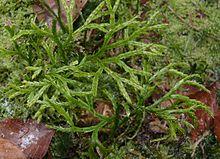| Diphasiastrum | |
|---|---|
 | |
| Diphasiastrum complanatum (previously called Lycopodium complanatum). | |
| Scientific classification | |
| Kingdom: | Plantae |
| Clade: | Tracheophytes |
| Clade: | Lycophytes |
| Class: | Lycopodiopsida |
| Order: | Lycopodiales |
| Family: | Lycopodiaceae |
| Subfamily: | Lycopodioideae |
| Genus: | Diphasiastrum Holub |
| Species | |
| See text | |
Diphasiastrum is a genus of clubmosses in the plant family Lycopodiaceae. In the Pteridophyte Phylogeny Group classification of 2016 (PPG I), it is placed in the subfamily Lycopodioideae.[1] It is closely related to the genus Lycopodium, and some botanists treat it within a broad view of that genus as a section, Lycopodium sect. Complanata. Some species superficially resemble diminutive gymnosperms and have been given common names such as ground-pine or ground-cedar.
There are 16 species, and numerous natural hybrids in the genus; many of the hybrids are fertile, allowing their occurrence to become frequent, sometimes more so than the parent species. The basal chromosome count for this genus is n=23, which is distinctively different from other lycopods.
Several species have been used economically for their spores, which are harvested as Lycopodium powder.
Species
As of December 2019, the Checklist of Ferns and Lycophytes of the World recognized the following species:[2]
- Diphasiastrum alpinum (L.) Holub – alpine clubmoss; circumpolar, subarctic and alpine
- Diphasiastrum angustiramosum (Alderw.) Holub – New Guinea
- Diphasiastrum carolinum (Lawalrée) Holub
- Diphasiastrum complanatum (L.) Holub – flat-stemmed clubmoss, northern running-pine, or ground cedar; circumpolar, cool temperate
- Diphasiastrum digitatum (Dill. ex A.Br.) Holub – fan clubmoss, southern running-pine, or running cedar; eastern Canada, northeastern United States, Appalachian Mountains
- Diphasiastrum falcatum B.Øllg. & P.G.Windisch
- Diphasiastrum fawcettii (F.E.Lloyd & Underw.) Holub – Jamaica, Hispaniola
- Diphasiastrum henryanum (E.D.Br. & F.Br.) Holub – Marquesas Islands
- Diphasiastrum madeirense (J.H.Wilce) Holub – Madeira, Azores
- Diphasiastrum multispicatum (J.H.Wilce) Holub – Taiwan, Philippines
- Diphasiastrum nikoense (Franch. & Sav.) Holub – Japan
- Diphasiastrum oellgaardii Stoor, Boudrie, Jérôme, K.Horn & Bennert
- Diphasiastrum platyrhizoma (J.H.Wilce) Holub – Borneo, Sumatra
- Diphasiastrum sitchense (Rupr.) Holub – Alaskan clubmoss; northern North America
- Diphasiastrum thyoides (Humb. & Bonpl. ex Willd.) Holub – Caribbean, Central and South America
- Diphasiastrum tristachyum (Pursh) Holub – blue clubmoss, blue ground-cedar; circumpolar, cool temperate
- Diphasiastrum veitchii (Christ) Holub – Veitch's clubmoss; eastern Himalayas east to Taiwan
- Diphasiastrum wightianum (Wall. ex Hook. & Grev.) Holub – southeast Asia, New Guinea
- Diphasiastrum yueshanense (C.M.Kuo) Holub – Taiwan
- Diphasiastrum zanclophyllum (J.H.Wilce) Holub
- Diphasiastrum zeilleri (Rouy) Holub
Selected hybrids
Some species are treated as hybrids, although not by all sources:[2]
- Diphasiastrum × habereri (House) Holub (D. digitatum × D. tristachyum)
- Diphasiastrum × issleri (Rouy) Holub (syn. D. issleri, D. alpinum × D. complanatum)
- Diphasiastrum × sabinifolium (Willd.) Holub (syn. D. sabinifolium, D. sitchense × D. tristachyum)
- Diphasiastrum × verecundum A.V.Gilman (D. complanatum × D. digitatum)
Distribution
The genus has a subcosmopolitan distribution, in much of the Northern Hemisphere, south in mountains to South America (reaching furthest south in Jujuy Province, northwest Argentina), New Guinea and the Marquesas Islands in the Pacific Ocean, but confined to climates with high humidity for most or all of the year (or, in cool climates, protected by snow cover in winter).
References
- ^ PPG I (2016), "A community-derived classification for extant lycophytes and ferns", Journal of Systematics and Evolution, 54 (6): 563–603, doi:10.1111/jse.12229
- ^ a b Hassler, Michael & Schmitt, Bernd (November 2019), "Diphasiastrum", Checklist of Ferns and Lycophytes of the World, 8.11, retrieved 2019-12-09
External links
- Holub, J. 1975. Diphasiastrum, a new genus in Lycopodiaceae. Preslia 14: 97-100.
- Lycopodiaceae list (treats genus within Lycopodium but gives Diphasiastrum names in synonymy)
- Flora of North America - Diphasiastrum
- Photo of D. complanatum
- Picture and information
- Pictures
